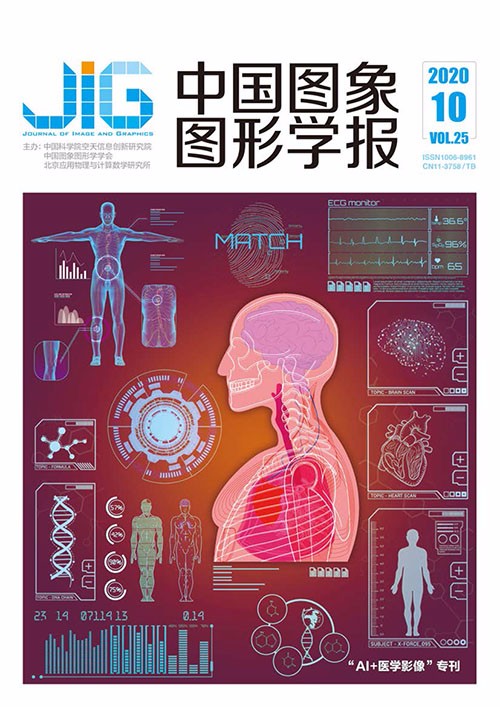
等强度婴儿脑MR图像分割的深度学习方法综述
摘 要
磁共振(magnetic resonance,MR)成像作为一种安全非侵入式的成像技术,可以提供高分辨率且具有不同对比度的大脑图像,被越来越多地应用于婴儿大脑研究中。将婴儿脑MR图像准确地分割为灰质、白质和脑脊液,是研究早期大脑发育模式不可或缺的基础处理环节。由于在等强度阶段(6~9月龄)婴儿脑MR图像中,灰质和白质信号强度基本一致,组织对比度极低,导致此阶段的脑组织分割非常具有挑战性。基于深度学习的等强度婴儿脑MR图像分割方法,由于其卓越的性能受到研究人员的广泛关注,但目前尚未有文献对该领域的方法进行系统总结和分析。因此本文对目前基于深度学习的等强度婴儿脑MR图像分割方法进行了系统总结,从基本思想、网络架构、性能及优缺点4个方面进行了介绍。并针对其中的典型算法在iSeg-2017数据集上的分割结果进行了对比分析,最后对等强度婴儿脑MR图像分割中存在的问题及未来研究方向进行展望。本文通过对目前基于深度学习的等强度婴儿脑MR图像分割方法进行总结,可以看出深度学习方法已经在等强度期婴儿脑分割中展现出巨大优势,相比传统方法在分割精度和效率上均有较大提升,将进一步促进人类人脑早期发育研究。
关键词
Review of deep learning methods for isointense infant brain MR image segmentation
Zhang Hang1, Wang Yaping1, Geng Xiujuan2, Fu Pengfei1(1.School of Information Engineering, Zhengzhou University, Zhengzhou 450001, China;2.Brain and Mind Institute, Chinese University of Hong Kong, Hong Kong 999077, China) Abstract
Emerging interest has been shown in the study of infant brain development by using magnetic resonance (MR) imaging because it provides a safe and noninvasive way of examining cross-sectional views of the brain in multiple contrasts. Quantitative analysis of brain MR images is a conventional routine for many neurological diseases and conditions, which relies on the accurate segmentation of structures of interest. Accurate segmentation of infant brain MR images into white matter (WM), gray matter (GM), and cerebrospinal fluid is of great importance in studying and measuring normal and abnormal early brain development. However, in the isointense phase (6-9 months of age), WM and GM exhibit similar levels of intensity in T1-weighted and T2-weighted MR images due to the inherent myelination and maturation, posing significant challenges for automated segmentation. Compared with traditional methods, deep learning-based methods have greatly improved the accuracy and efficiency of isointense infant brain segmentation. Thus, deep learning-based segmentation methods have been increasingly used by researchers due to their excellent performance. Nevertheless, no literature has systematically summarized and analyzed the methods in this field. The current study aims to review existing deep learning-based approaches for isointense infant brain MR image segmentation. With the extensive research in the literature, we systematically summarized the current deep learning-based methods for isointense infant brain MR image segmentation. We first introduced an authoritative isointense infant brain segmentation dataset, which was used in the iSeg-2017 challenge, hosted as a part of the Medical Image Computing and Computer Assisted Intervention Society Conference 2017. Afterward, several evaluation metrics, including Dice coefficient, 95th-percentile Hausdorff distance, and average symmetric surface distance, were briefly described. We classified the existing deep learning-based methods for isointense infant brain MR image segmentation into two categories: 2D and fully convolutional neural network-based methods. Fully convolutional neural network-based methods can be further divided into two subcategories: 2D and 3D network-based approaches. On the basis of the two categories, we comprehensively described and analyzed the basic ideas, network architecture, improvement schemes, and segmentation performance of each method. In addition, we compared the performance of some existing deep learning-based methods and summarized the analysis results of typical methods on the iSeg-2017 dataset. Lastly, three possible research directions of isointense infant brain MR image segmentation methods based on deep learning were discussed. We drew three main conclusions by reviewing the main work in this field, thereby providing a good overview of existing deep learning methods for isointense infant brain MR image segmentation. First, using multimodality data is beneficial for the network to obtain rich feature information, which can improve the segmentation accuracy. Second, compared with 2D fully convolutional network-based methods, 3D-based methods for MR image brain segmentation can integrate richer spatial context information, resulting in higher accuracy and efficiency. Third, adopting complicated network architecture and dense network connection could make the network achieve superior accuracy performance. Three possible future directions, namely, embedding powerful feature representation modules (e.g., attention mechanism), adding prior knowledge of the infant brain to the network model (e.g., the cortical thickness of infant brain is within a certain range), and constructing a semisupervised or weakly supervised network model trained with a small amount of labeled data, were recommended. Precise segmentation of infant brain tissues is an essential step towards comprehensive volumetric studies and quantitative analysis of early brain development. Deep learning has shown great advantages in isointense infant brain segmentation, and its accuracy and efficiency have been greatly improved compared with traditional methods. With the development of deep learning, it will bring further improvement in the research field of isointense infant brain segmentation and promote the research of early human brain development.
Keywords
magnetic resonance imaging isointense phase infant brain segmentation deep learning convolutional neural network
|



 中国图象图形学报 │ 京ICP备05080539号-4 │ 本系统由
中国图象图形学报 │ 京ICP备05080539号-4 │ 本系统由